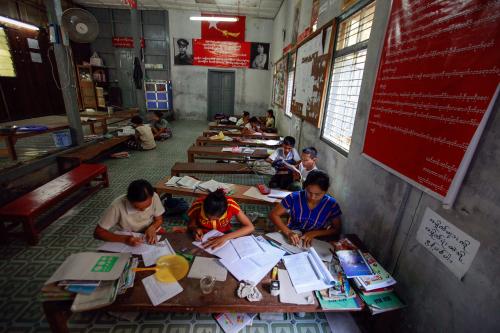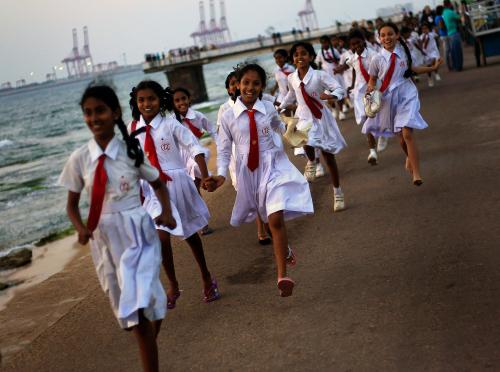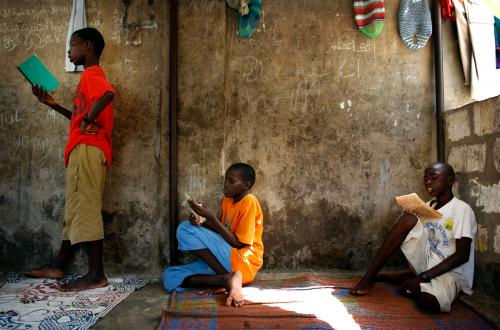One of the key questions facing the framers of the post-2015 agenda is how to best address education access, quality, outcomes and equity. While the Millennium Development Goal targets successfully prioritized schooling access, the last 15 years have illustrated that schooling access must be paired with actions that address education quality. Moreover, the expansion of access seen so far has left behind many of the most marginalized and poor children, including girls, and many who are in school face the “hidden exclusion” of being in school but not learning.
Lively discussions among U.N. member states, U.N. agencies and civil society representatives are helping to craft meaningful goals and targets to shape international education policies. At the crux of these discussions are two proposals for education goals and targets: one from the inter-governmental Open Working Group (OWG) on Sustainable Development Goals and the other from the Education for All Steering Committee (EFA SC).
But with two global proposals, how do we know which language to use in a post-2015 framework? The following summarizes the key differences between the two major proposals:
1. Early Childhood Education
While both of the targets focus on quality early childhood development and education, the OWG target does not highlight primary school readiness. Only the EFA target specifies that pre-primary education should be free of cost.
OWG: “By 2030 increase by x% the proportion of children able to access and complete inclusive quality pre-primary education and other early childhood development programmes.
EFA: By 2030, at least x% of girls and boys are ready for primary school through participation in quality early childhood care and education, including at least one year of free and compulsory pre-primary education, with particular attention to gender equality and the most marginalized.
2. Primary and secondary education
Both targets call for free education that leads to relevant learning outcomes and both emphasize equity. However, the EFA target calls for basic education to be compulsory and specifies the number of years—nine— to be completed, while the OWG target only specifies the levels of education—primary and secondary—to be completed.
OWG: By 2030 ensure all girls and boys complete free, equitable and quality primary and secondary education leading to relevant and effective learning outcomes.”
EFA: By 2030, all girls and boys complete free and compulsory quality basic education of at least nine years and achieve relevant learning outcomes, with particular attention to gender equality and the most marginalized.”
3. Literacy and Numeracy
Both goals both focus on achieving youth literacy and numeracy and increasing adult literacy and numeracy. The EFA target specifically highlights the level of literacy and numeracy according to skills needed for participation in society.
OWG: “Achieve universal youth literacy and basic numeracy and an increase by x% of adult literacy and basic numeracy by 2030.”
EFA: By 2030, all youth and at least x% of adults reach a proficiency level in literacy and numeracy sufficient to better participate in society, with particular attention to girls and women and the most marginalized.
4. Tertiary education and lifelong learning
The EFA target highlights purpose, levels, and specific elements of effective lifelong learning. While the OWG target highlights access to affordable tertiary education and lifelong learning, it is relatively unspecific. However, OWG target 17.15 calls for expanded higher education scholarships with a focus on the fields of science, engineering, health, economics, finance, management and sustainable development.
OWG: By 2030 ensure equal access for all to affordable quality tertiary education and life-long learning.
EFA: By 2030, at least x% of youth and y% of adults have the knowledge and skills for decent work and life through technical and vocational, upper secondary and tertiary education and training, with particular attention to gender equality and the most marginalized.”
5. Skills for employment
Both targets highlight skills needed for employment, including technical and vocational training; the OWG target specifically highlights ICT, technical, engineering and scientific skills, while the EFA target highlights upper secondary and tertiary education and training. Moreover, the EFA target moves beyond the purpose of skills for employment to also include knowledge and skills for life.
OWG: By 2030 increase by x% the number of young and adult women and men with the skills needed for employment, including vocational training, ICT, technical, engineering and scientific skills.
EFA: By 2030, at least x% of youth and y% of adults have the knowledge and skills for decent work and life through technical and vocational, upper secondary and tertiary education and training, with particular attention to gender equality and the most marginalized.”
6. Education for sustainable development
Both targets are focused on the knowledge and skills for sustainable development; however, the OWG target also highlights cultural education while the EFA target highlights global citizenship education. Furthermore, the EFA target includes reference to attitudes and values as well as the purpose of such education, aimed at establishing sustainable and peaceful societies.
OWG: By 2030 integrate relevant knowledge and skills in education curricula and training programs, including education for sustainable development and awareness raising on culture’s contribution to sustainable development.
EFA: By 2030, all learners acquire knowledge, skills, values and attitudes to establish sustainable and peaceful societies, including through global citizenship education and education for sustainable development.
7. Teachers
The EFA target directly calls on governments to ensure that teachers are qualified, trained, motivated and well-supported while the OWG target uses less direct and more vague language of enhancing quality through promoting teacher training. Additionally, the EFA target includes “motivated” and “well-supported” as a focus of the target for teachers, both of which are important but may be difficult to measure given the lack of a global consensus on and definition for such terms.
OWG: “By 2030 enhance the quality of teaching through promoting training for teachers.”
EFA: “By 2030, all governments ensure that all learners are taught by qualified, professionally-trained, motivated and well-supported teachers.
Quantifying the Targets
EFA targets include the percentages of all youth and adults who should have these educational opportunities and skills as opposed to percent increases in the OWG targets. This distinction forces us to consider what we mean by universality in the targets.
For the EFA targets, the implication is that every country should commit to the same percentage of access, learning, etc. “Universality” here applies to the human dimension: children deserve the same opportunities regardless of where they live. In this case, developing countries will have a higher level of required effort to reach the target. Thus, in a sample case where a target is 50 percent, developing country A will have to move from 25 percent to 50 percent, while developed country B will have to move from 46 percent to 50 percent).
In the case of the OWG targets, the interpretation of universality applies on a country level, where every country should have a relatively equal level of effort (percentage change) from the baseline. The rationale is that countries are coming from different baselines, targets should be relative. Therefore, in an example case where the target is a 20 percent increase, developing country A will have to move from 25 percent to 30 percent, while developed country B will have to move from 46 percent to 55.2 percent. In this case, it is a slightly bigger lift for the developed country.
Targets Without A Direct Comparison
There are several additional targets in each of the proposals that do not have directly comparable versions in the other document. For example, the EFA document includes a target that specifically suggests percentages of GDP to be invested in education, while OWG includes a broader section on financing that emphasizes capacity building and the responsibility of developed countries. Another example is the OWG’s target on safe school environments. While there is no comparable target within the EFA list of targets, the text of the Muscat Agreement acknowledges the need for safe learning environments. Finally, the OWG document includes a target that focuses specifically on equitable access to inclusive education and training. The EFA Steering Committee’s targets integrate equity (gender equality and the most marginalized) into individual target areas rather than including a stand-alone target.
What are the Next Steps?
OWG members are currently engaged in consultations with U.N. Member States’ delegations, and at the same time, the Education for All Steering Committee has asked the global education community to support their targets in the post-2015 discussions, including the OWG consultations. The global education community is currently developing relevant indicators for each global target, and n EFA Framework of Action will be debated throughout the next year and finalized at the World Forum on Education in the Republic of Korea in May 2015.
There is still a lot of work to be done to ensure that all aspects of quality education are included in the post-2015 framework. Ultimately, this will ensure that quality education is prioritized within all countries’ development strategies for the next 15 years.








Commentary
A User’s Guide to the Post-2015 Agenda Education Targets
June 18, 2014